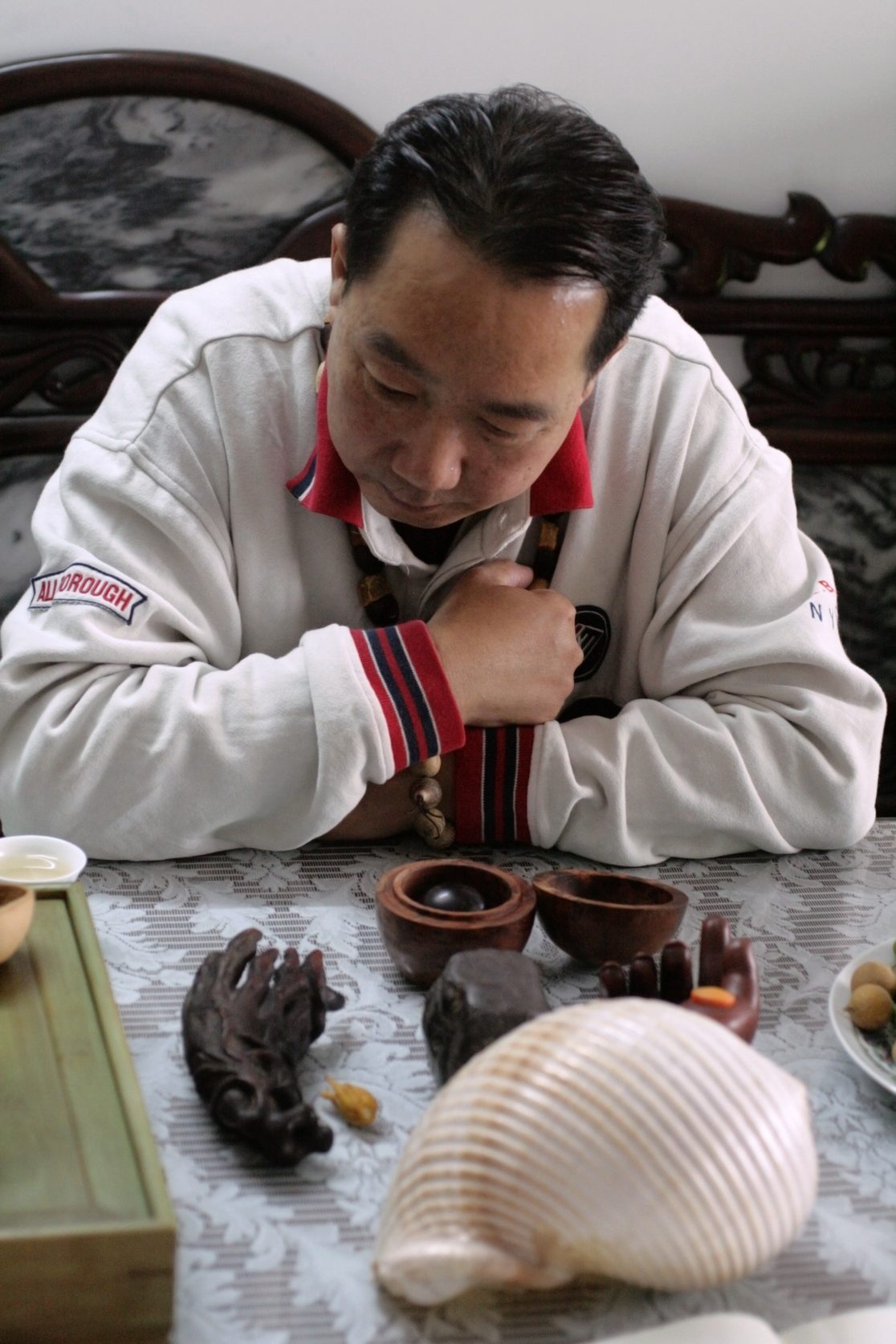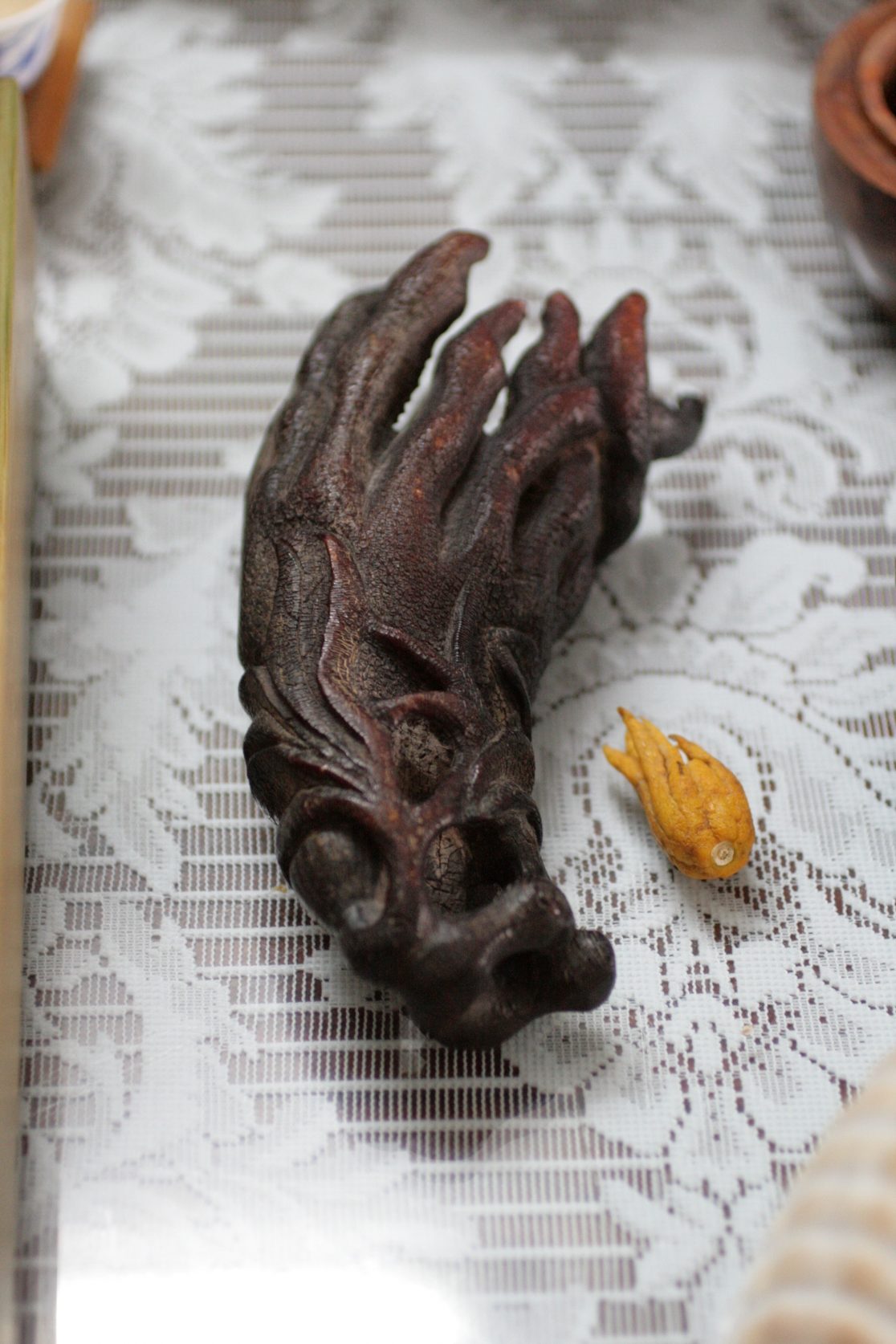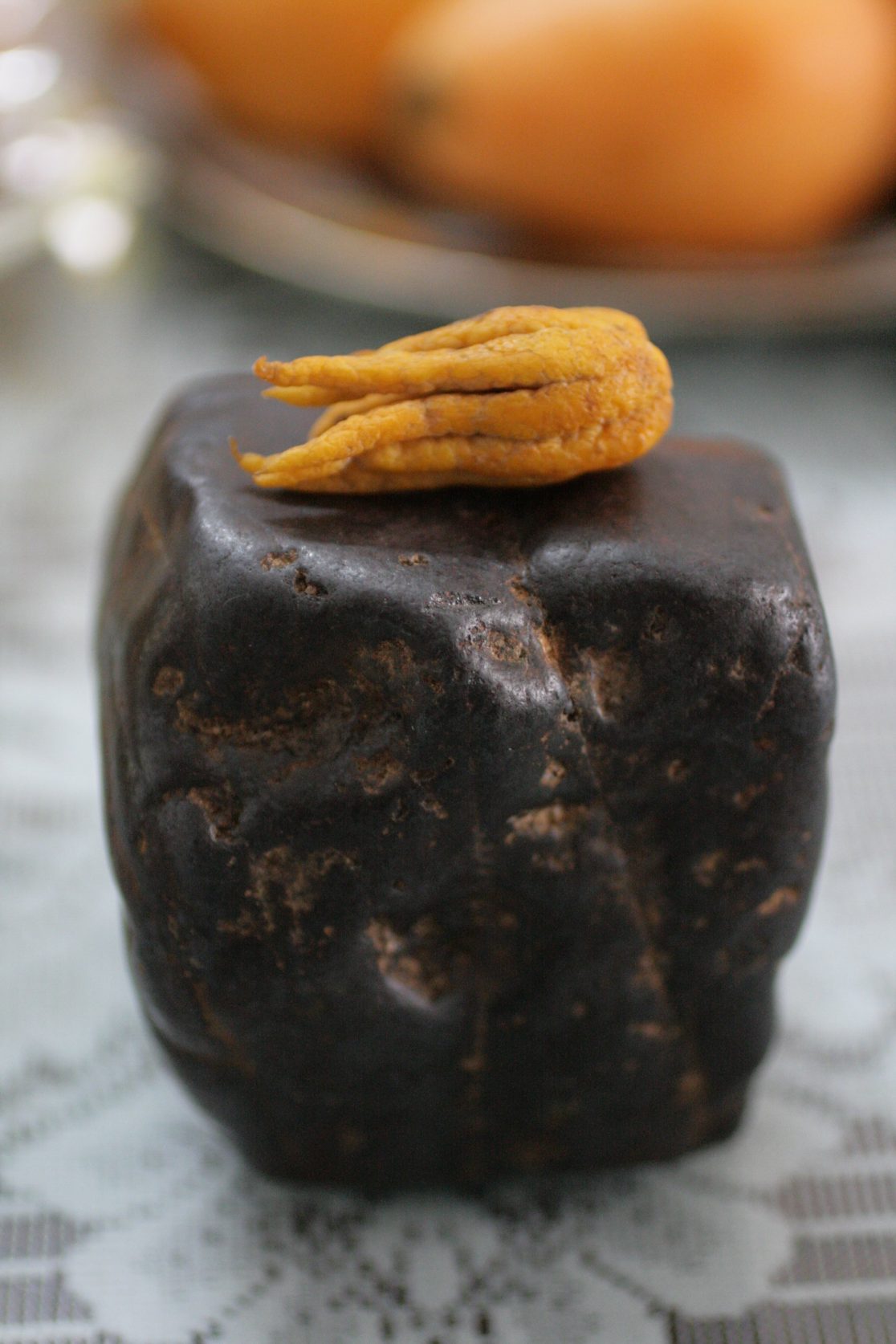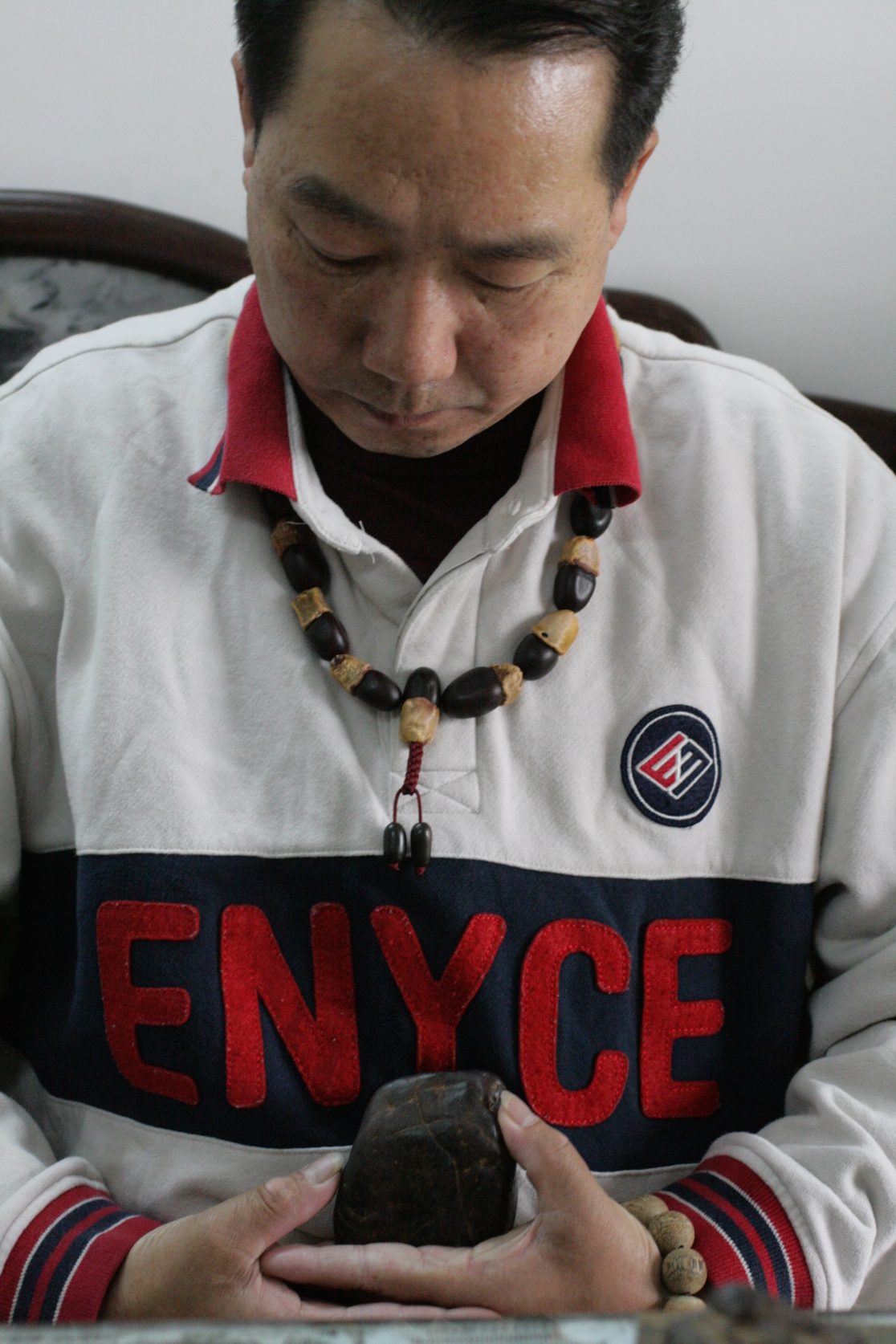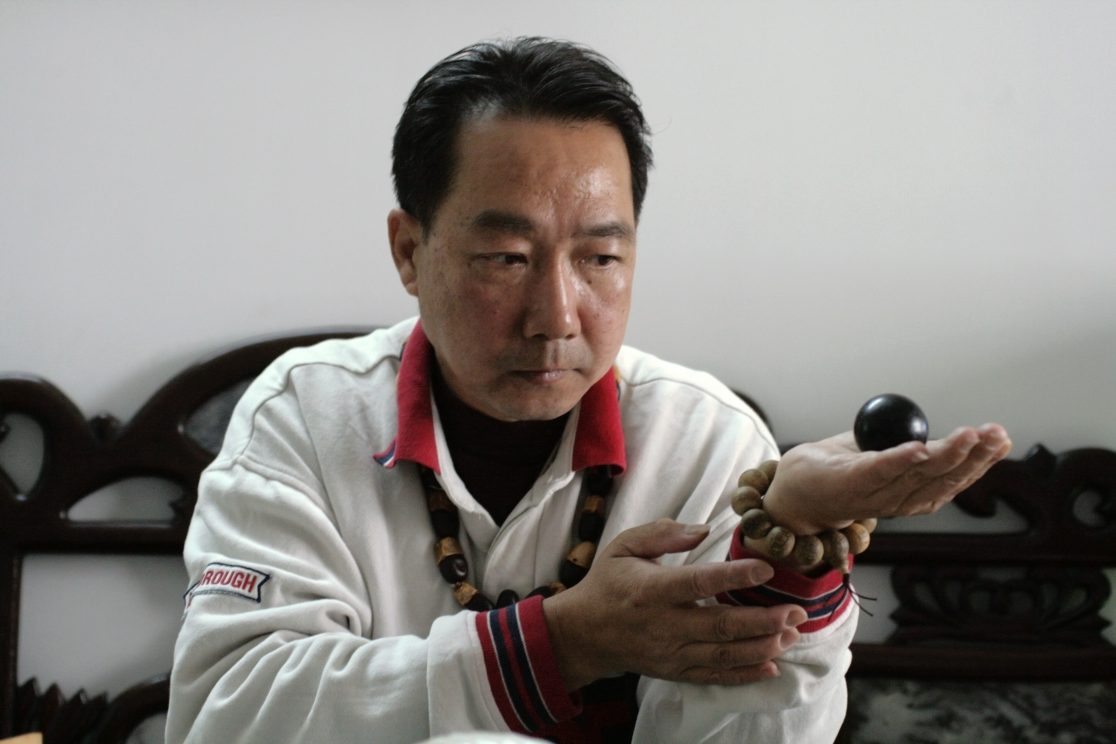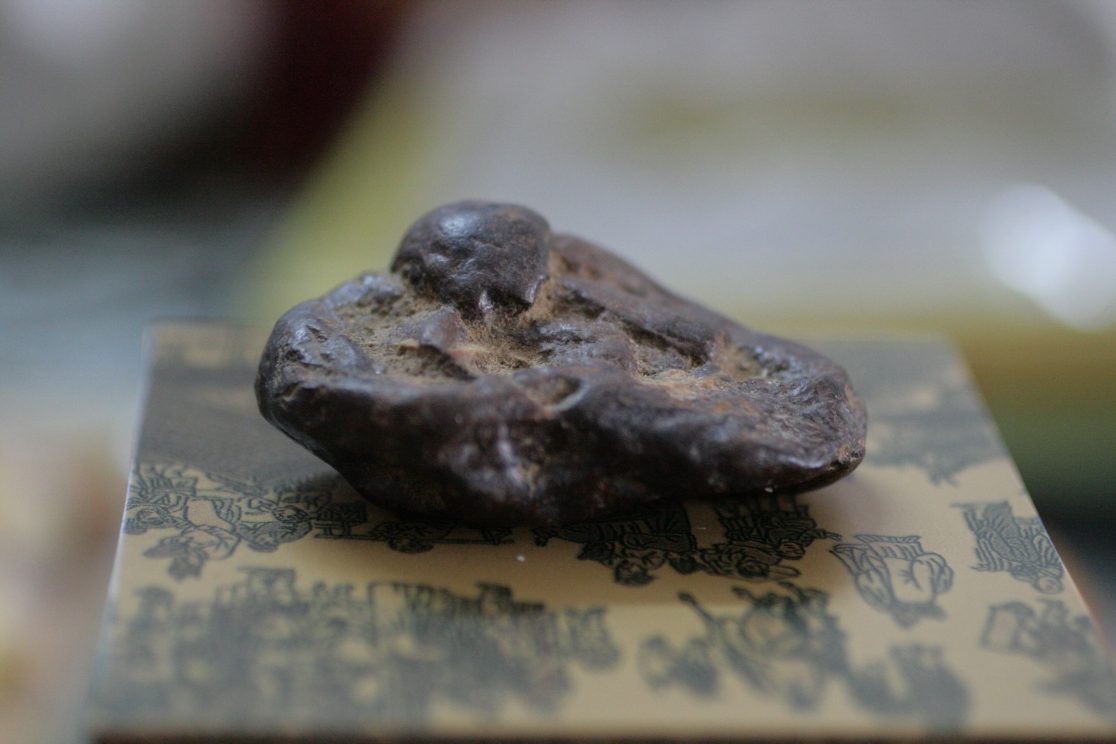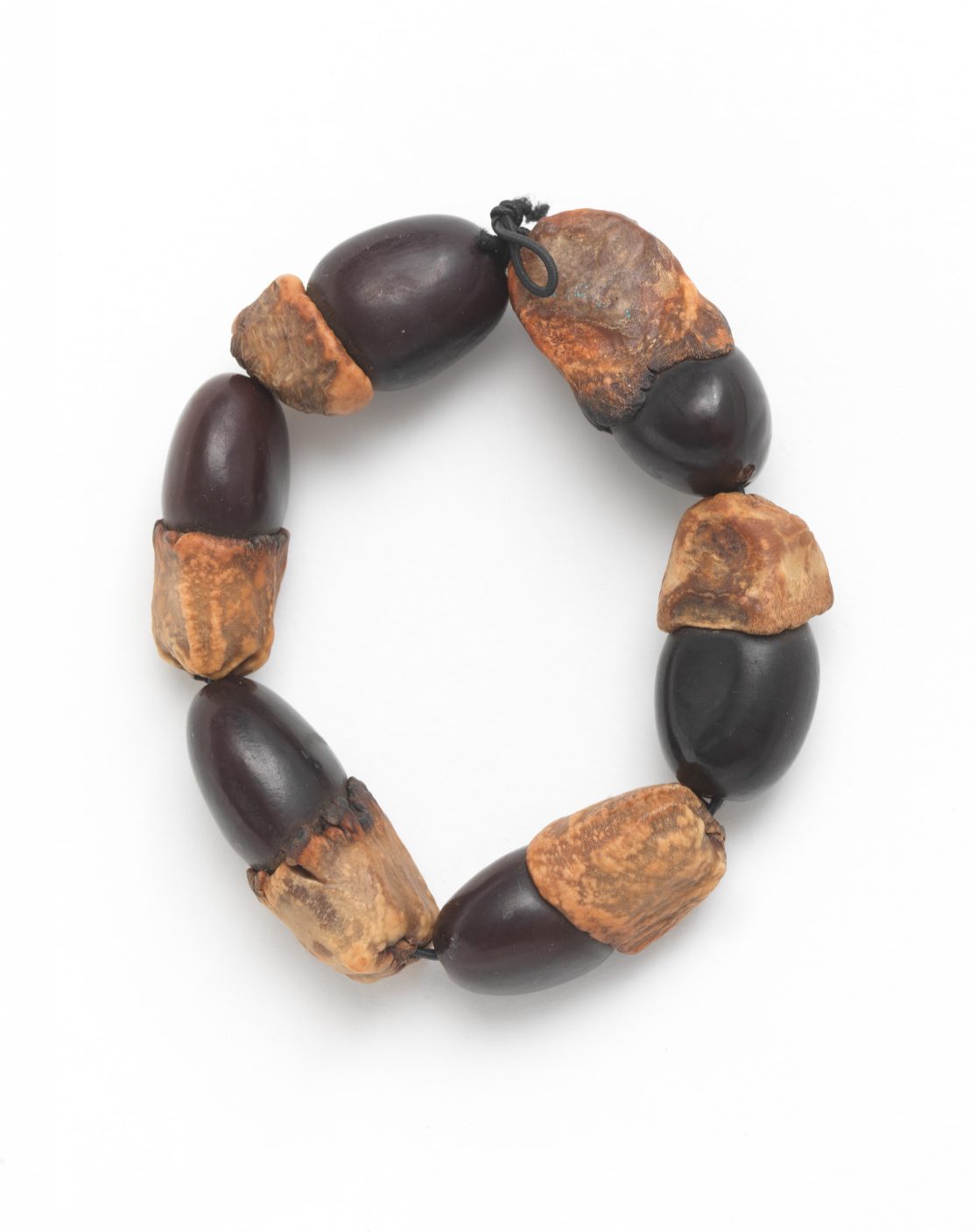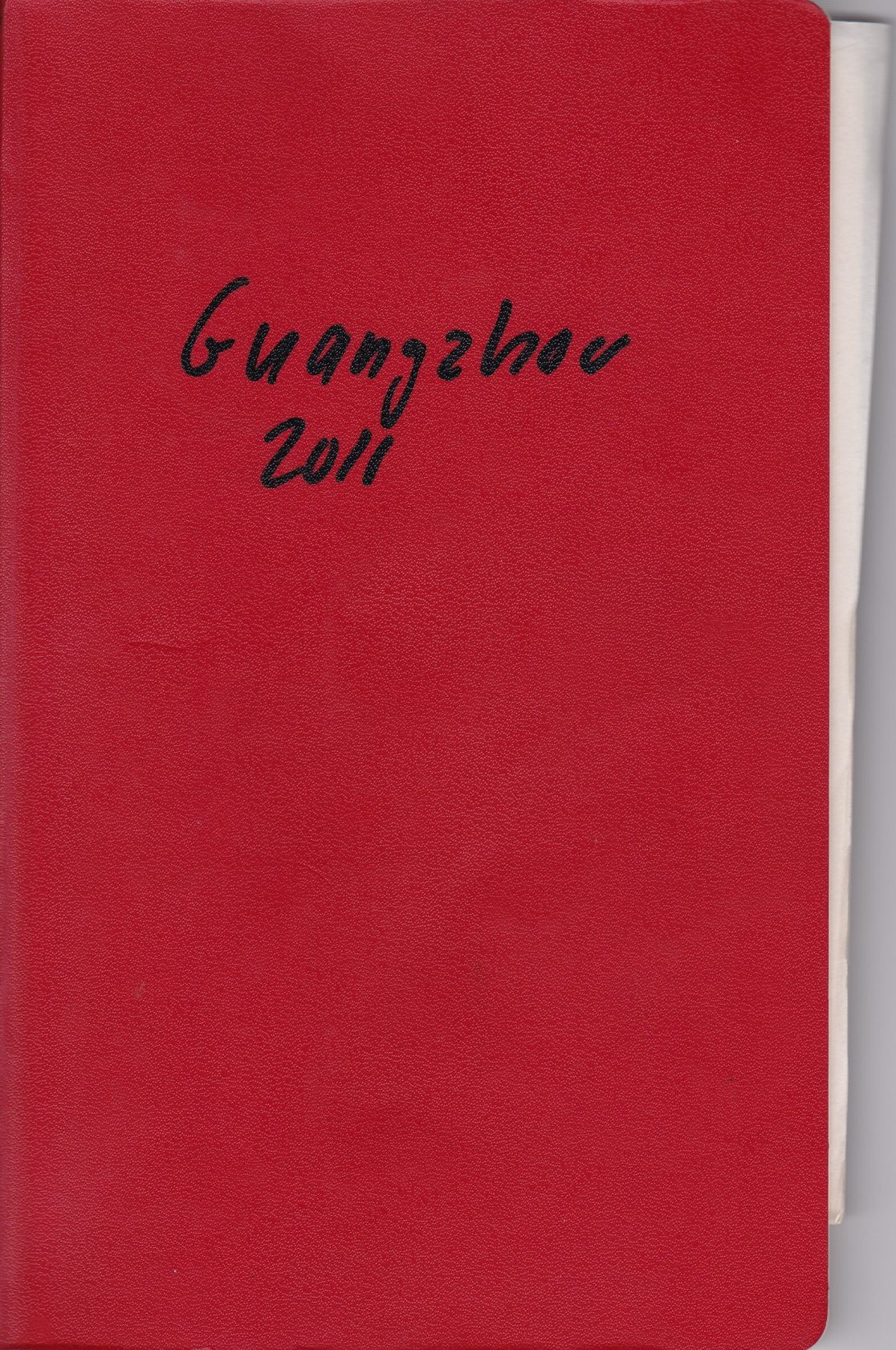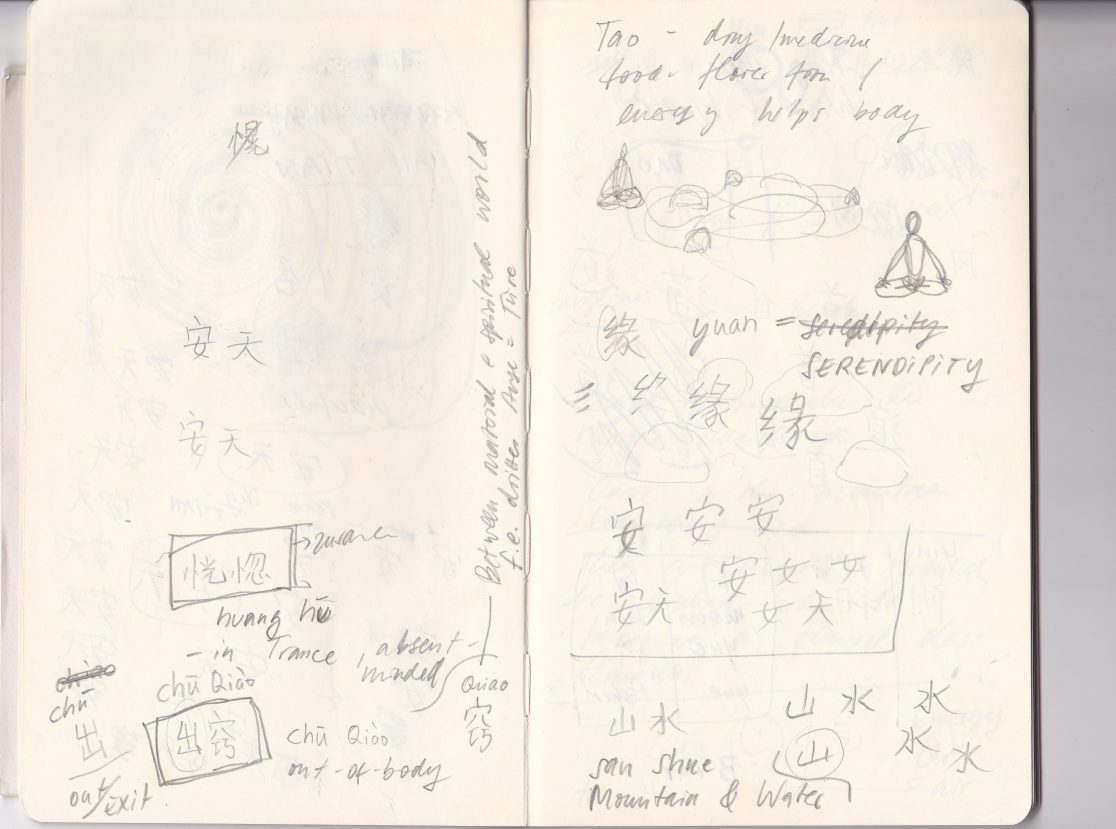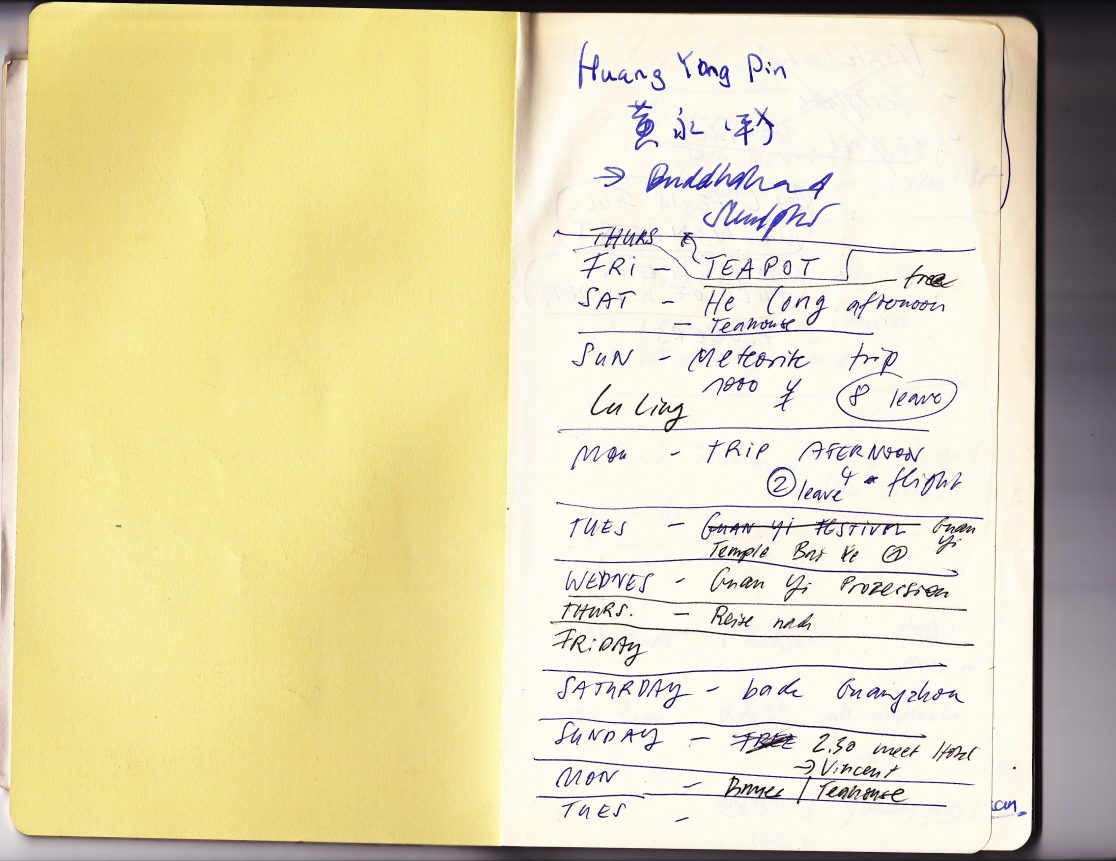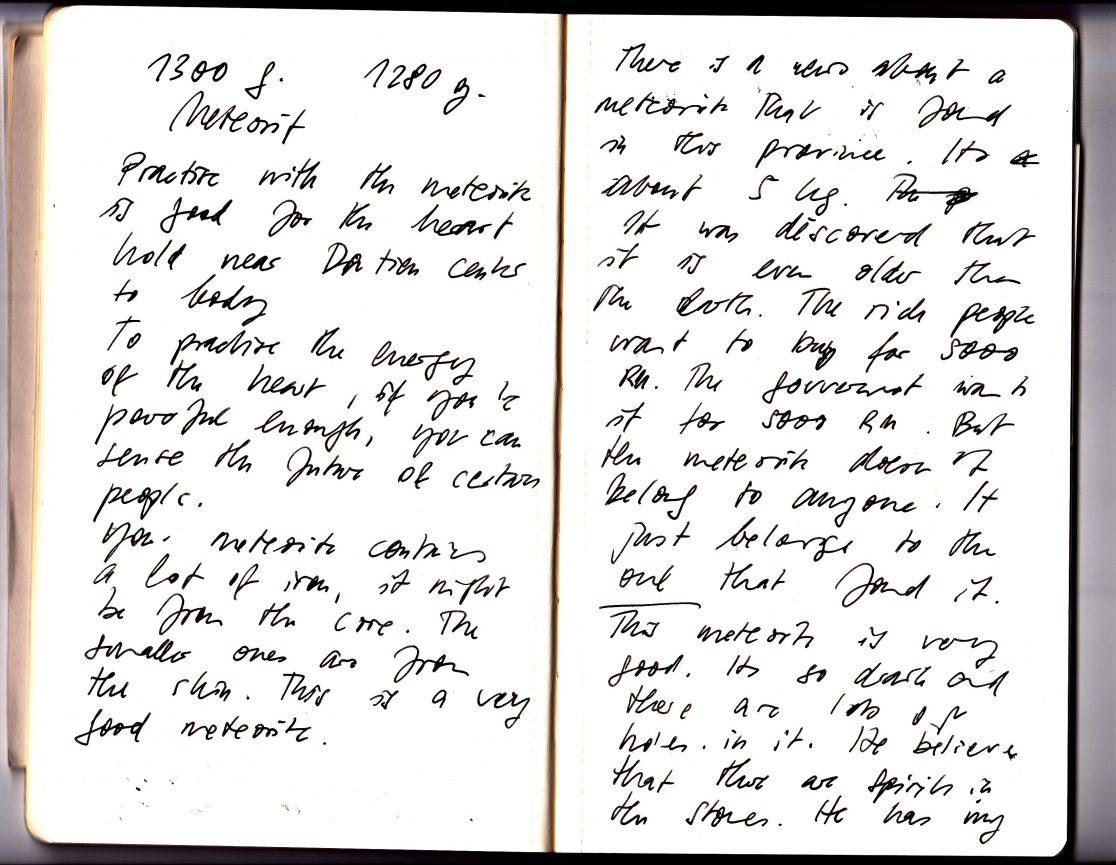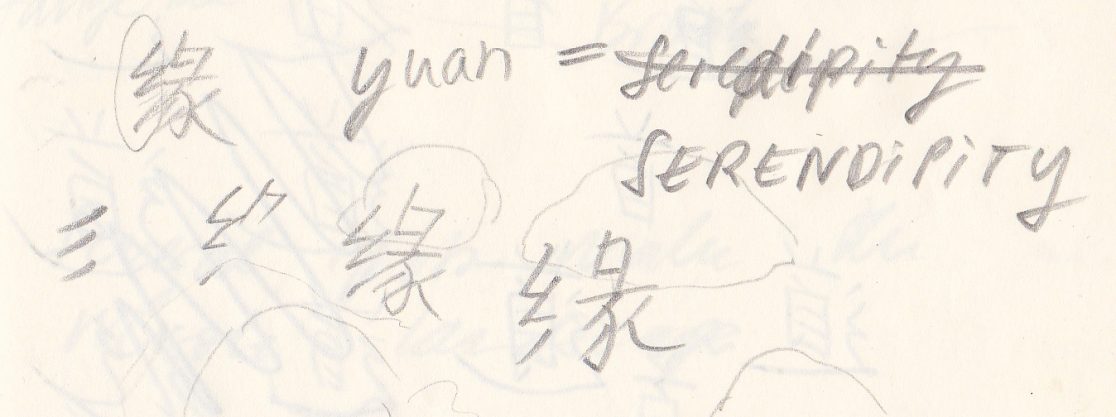How to Practice the Energy of the Heart. Conversation between Ma Xiaozhong and Antje Majewski. Guangzhou, 2011
On my journey to find out more about the Meteorite, I met Ma Xiaozhong, the uncle of my assistant Shuxian Xu, in Guangzhou, South China. He was a Feng Shui-master. Ma Xiaozhong worked for a company which produced traditional Chinese medicine, and he gave advice to friends for free. He was also able to interpret the I Ching. Even before we began the conversation, he gave me a bracelet which he had worn himself; it was similar to the necklace he wore around his neck. The fruit had a skin that resembled an animal’s skin more than that of a plant. For my part, I brought him a meteorite which the villagers had gifted to me. He was delighted about it because he saw a reclining Buddha in it. The reclining Buddha shows the moment before Buddha enters Nirvana – lying on one side and smiling.
Ma Xiaozhong agreed to talk to me about the meteorite, but he did not want to be filmed. I took a few pictures and notes during the talk, the transcript of which can be found further down. With him, too, the meteorite turns into a living, active being that can help with meditation. He showed me how to best hold it in front of the Dantian, the centre of the body/being. Of my objects, he liked the black sphere best. It reminded him of an animal bead and it could be used for healing people.
Ma Xiaozhong died peacefully from a heart disease a few months after our meeting. I am very grateful that I was able to get to know him.
Transcript of the notes Antje Majewski took during her conversation with the Feng Shui-master Ma Xiaozhong, 2011
1300 g. 1280 g.
Meteorit
Practice with the meteorite is good for the heart
hold near Dan tian[1] center to body
To practice the energy of the heart, if you are powerful enough, you can sense the future of certain people.[2]
Your meteorite contains a lot of iron, it might be from the core. The smaller ones are from the skin. This is a very good meteorite.
There is news about a meteorite that is found in this province. It’s about 5 kg. It was discovered that it is even older then the earth. The rich people want to buy for 5000 RMB. The government wants it for 5000 RMB. But the meteorite doesn’t belong to anyone. It just belongs to the one that found it.
_______
This meteorite is very good. It’s so dark and there are lots of holes in it. He believe that there are spirits in the stones[3]. He has my stone now because of Yuan[4].
The small one looks like a reclining Buddha[5] and like a turtle[6].
_______
There are two meteorites in the village. One is gone, some one took it.
_______
similar to泰山石. (Tai shan stone) [7]
famous stone in China and he thinks it’s older than the Tai shan stone. Tai Shan is very tough and very hard but he thinks that this is even better. Tai shan is also very expensive.
_______
People also use this kind of meteorite to guard their house.
Here this meteorite might cost very much, maybe 1000 Yuan, but smaller ones.
Sometimes the object can bring me good luck, when you meet the object it can bring you…
somewhere else its Yuen.
[1]丹田Here: the lower Xia dantian, a bit below the navel. Dantian means the energy centre of human beings in Daoism. The lower Xia dantian is the place of the Qi of a human being, the most important center of energy in the body, that needs to be in motion. The meteorite can be used to take care of or cure this energy field.
[2] To meditate with stones is the most natural thing in the world from the view of a Daoist, since they are by nature “an uncarved wood” (Pu 朴). This is the ideal way of becoming one with Dao: to be natural (自然), honest, and in harmony with nature. Furthermore, a stone is a natural master of Wu Wei (无为). Wu Wei is very difficult to translate: „To do nothing, yet all is done“ (Zuangzhi); to act in harmony with the Dao in a way that one’s own will and activity can’t be separated from it; it does it by itself; the stone is, what it is, by itself (Ziran自然).
[3]供石Gong Shi, Gong = Spirit, energy, Shi= stone. Also Scholar’s rocks or Viewing Stones. These can be small stones on pedestals for contemplation inside the house or huge garden stones. Known since the Tan-Dynasty, since Tang Dynasty we can find sources in literature about Gong Shi. They are originally stones formed by nature that contain the life energy Qi. They are classified according to origin (for instance from holy daoist mountains), surface, transgressivity / holes and form. A black stone can be very much appreciated. Many holes are also good, since they allow the Qi to circulate. Lou (hollows and channels) is one of the four main classifications, next to shou (an erect, elegant, slim figure), zhou (wrinkels, uneven surface) and tou (holes and emptiness). See also: Kemin Hu, Scholars’ Rocks in Ancient China: The Suyuan Stone Collection: The Suyuan Stone Catalogue, Orchid Press 2013
[4]缘分 Yuanfen. Serendipity. Lucky fate – mostly connected to the idea of kharma. To meet someone, or even an object, is a matter of Yuan. Ma Xiaozhong, who was given a small meteorite as a present by me, saw in it the dying Buddha on the verge of Nirvana as well as the daoist symbol of the Universe, the unity of Yin and Yang (the turtle) and died peacefully some weeks later. What could be interpreted as a misfortune for someone else, is in this context Yuanfen.
[5] mahāparinabbāna: the last moments of Buddha before his death. The lying Buddha is reclining on one side. The pose shows Buddha just before entering Nirvana and is very popular in all Asia.
[6]龜the tortoise is sacred and symbolizes longevity, power, and tenacity. The creator goddess Nuwa or Nugua cuts the legs off a sea turtle and uses them to prop up the sky after Gong Gong destroys the mountain that had supported the sky. The flat plastron and domed carapace of a turtle parallel the ancient Chinese idea of a flat earth and domed sky. Therfore, the tortoise symbolizes the universe. Quoting Pen T’sao, “the upper dome-shaped part of its back has various signs, which correspond with the constellations on the sky, and this is Yan; the lower part has many lines, which relate to the earth and is the Yin.
[7]泰山 Tai Shan is one of the five Holy Mountains of Daoism. It is situated north of the city of Tai’an in the province of Shandong. The Tai Shan Stone (泰山石) is a grey Gong Shi with visible veins, which wards of bad energies and beings.
Texts:
Antje Majewski: Der Meteorit, 2014 (dt)
Transcript of the notes Antje Majewski took during her conversation with the Feng Shui master Ma Xiaozhong, 2011
Transkript der Notizen, die Antje Majewski während des Gesprächs mit dem Feng-Shui-Meister Ma Xiaozhong machte (2011)
The Meteorite. Evaluated by Bernd Moser, Earth Sciences, Universalmuseum Joanneum
Antje Majewski. Der Meteorit / The Meteorite. Exh. cat. Heidelberg: Heidelberger Kunstverein, 2014.
See also:
The Meteorite. Conversation between Lu Ling, the Villagers of Yang Wu Xia and Antje Majewski. Yang Wu Xia, 2011
The Guardian of All Things that are the Case. The Eight Objects, 2009-2011
The Guardian of All Things that are the Case, 2011
Exhibitions:
Der Meteorit, Heidelberger Kunstverein, Heidelberg, DE, 2014
Publications:
Antje Majewski. Der Meteorit / The Meteorite. Exh. cat. Heidelberg: Heidelberger Kunstverein, 2014.
Adam Budak, Peter Pakesch (Ed.), Antje Majewski, The World of Gimel. How to make objects talk. Kunsthaus Graz / Sternberg Press, 2011
